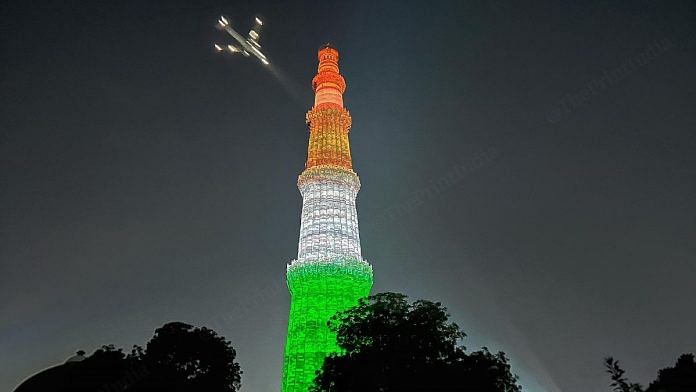New Delhi: Gleaming from afar at night, the Qutub Minar is a sight to behold. But now, the monument has turned into a canvas of a sound and light show that brings out the uniqueness of Indian villages. As the clock strikes 8:15 pm, the historic Delhi Sultanate-era minar springs to life as hues of yellow, blue, orange, and red seamlessly drape it.
In its 10-minute duration, the show celebrates the culture and traditions of 21 chosen villages. The Mera Gaon Meri Dharohar (MGMD) initiative is part of the larger Azadi Ka Amrit Mahotsav being organised by the Ministry of Culture. It aims to map the culture of 6.5 lakh villages, of which more than 2 lakh have already been covered.
Tagbin, a technology service company, collaborated with the government for the project, which was launched on 27 July, the same day when MGMD went online. A convergence of technology, artwork, and history, the Projection Mapping Show allows spectators to become part of an intangible dialogue between the past and the present.
Saurav Bhaik, an alumnus of the Indian Institute of Technology (IIT) Roorkee and now the CEO of Tagbin, says that the format “allows for an engaging and visually compelling representation” of the stories from Indian villages. The display captivates everyone on the premises during those 10 minutes. As all lights turn off in the complex, and the monument gets shrouded in complete darkness for a few minutes, visitors stay put in their places. And then suddenly, streams of light move up to the top of the Qutub Minar.
The immersive experience blends cultural symbols and historical traditions with breathtaking visual displays. The projected images merge with the Qutub Minar’s stonework, transforming the monument into a canopy.
“The rings and shapes of the projections were matching the angles of the monument. That was the best part of the show,” said Kusagra, one of the visitors at the complex who serendipitously watched the illuminations.
Also Read: Romila Thapar takes on camps of history, heroin addicts and storytellers
Why Qutub Minar
The selection of the venue for the Projection Mapping Show was strategic. The show is to be a permanent setup for the next five years, so it was necessary to select a backdrop that would not just deliver a visual spectacle but also reach a substantial audience.
“Qutub Minar, a heritage landmark, was selected due to its historical significance and popularity, ensuring a wide-reaching and impactful launch,” Bhaik said.
Tagbin’s endeavour to “showcase the depth and diversity” of India’s cultural landscape has led to the curation of content from every corner of the country. From the success of Tamil Nadu’s Odanthurai village which generates surplus wind energy and sells it to the government, to Meghalaya’s whistling village, Kongthong, where mothers compose a unique tune to call their babies instead of a name, the show captures these unique stories.
“Each village showcased possesses a unique and interesting facet, contributing to the narrative of India’s diverse heritage,” Bhaik said. The content of the show is set to evolve over time. Bhaik added that it will undergo content updates and enhancements to “showcase a wider range of village stories”.
Also Read: PM selfies to Gita pods, Tagbin wants India to do away with stuffy museums
Beyond the minar
Tagbin, founded in 2013, was at the helm of the Har Ghar Tiranga campaign, which it planned and managed in tandem with the Ministry of Culture in 2022. The agency also designed the Pradhanmantri Sangrahalaya or PM Museum, which was inaugurated in April 2022. It had also done another 3D show at Deepotsav in Uttar Pradesh.
The Projection Mapping Shown at Qutub Minar isn’t confined by spatial limitations. With projectors strategically placed to cover the entire monument, the visual delight can be enjoyed from the houses and rooftop restaurants dotted around the monument.
When the show is on, spectators in the nearby area can visit the portal to fully immerse themselves in the experience by listening to the audio of the show, Tagbin’s founder said. The same portal also provides an interactive projection mapping platform that allows visitors to select the projection patterns they want to see live on the Qutub Minar.
As dusk descends, light and laser shine on the monument’s intricate contours and architecture, and the towering minar briefly metamorphoses into a storyteller, akin to Burj Khalifa.
(Edited by Humra Laeeq)



